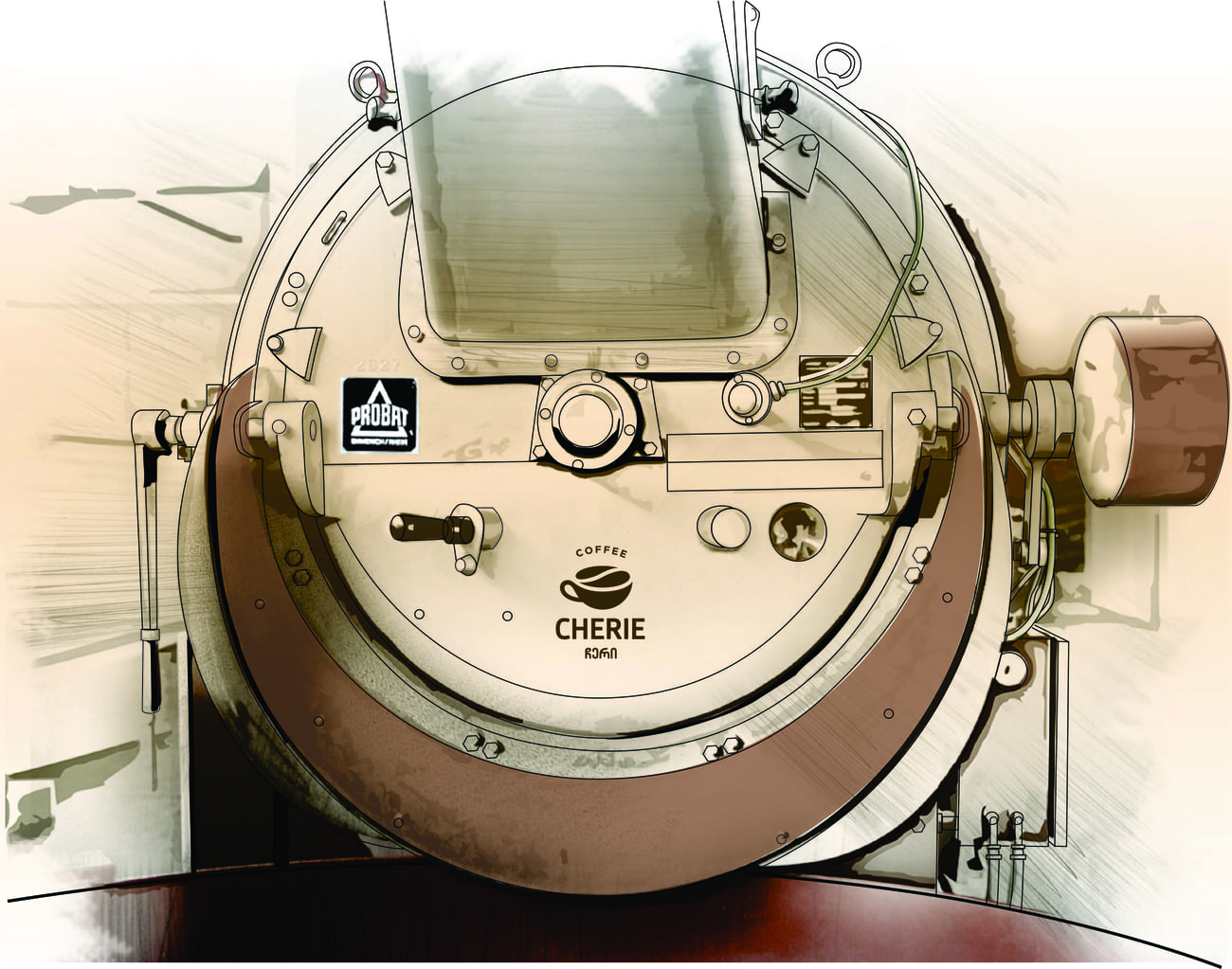Laboratory Inspection of the Green Coffee Beans
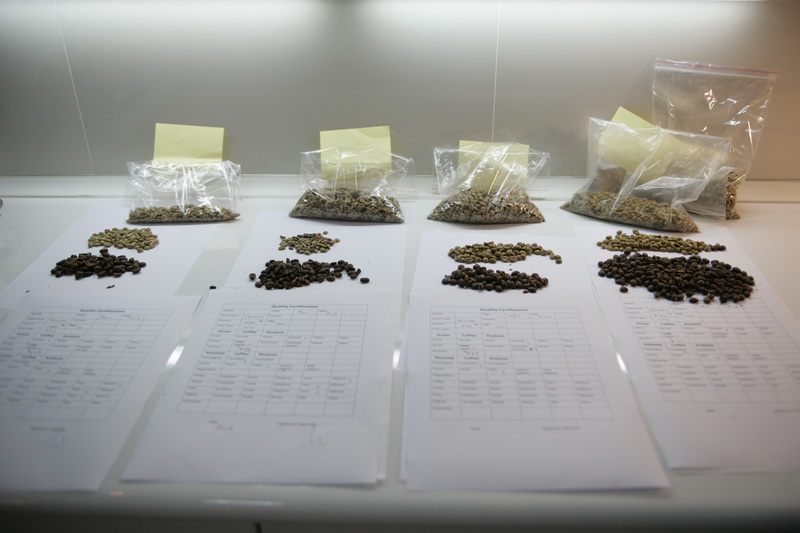 Prior to receiving bulk deliveries of green coffee beans, suppliers will send a small batch of samples approximately a month in advance, along with the associated certificates. These samples are then quality checked by our laboratory team who make use of state-of-the-art and German manufactured laboratory equipment. The quality control and inspection process involves measuring the moisture content of the coffee cherries, roasting a small batch in a mini-roaster, grinding the freshly roasted beans to the correct consistency and checking the colour with a spectrophotometer. Finally, of course, the coffee is brewed and tasted by our experts. In the case that the samples pass our quality control procedures, the supplier will then be instructed to ship the associated bulk consignment of green coffee beans to Georgia.
Prior to receiving bulk deliveries of green coffee beans, suppliers will send a small batch of samples approximately a month in advance, along with the associated certificates. These samples are then quality checked by our laboratory team who make use of state-of-the-art and German manufactured laboratory equipment. The quality control and inspection process involves measuring the moisture content of the coffee cherries, roasting a small batch in a mini-roaster, grinding the freshly roasted beans to the correct consistency and checking the colour with a spectrophotometer. Finally, of course, the coffee is brewed and tasted by our experts. In the case that the samples pass our quality control procedures, the supplier will then be instructed to ship the associated bulk consignment of green coffee beans to Georgia.
Receiving aBulk Consignment of Green Coffee Beans
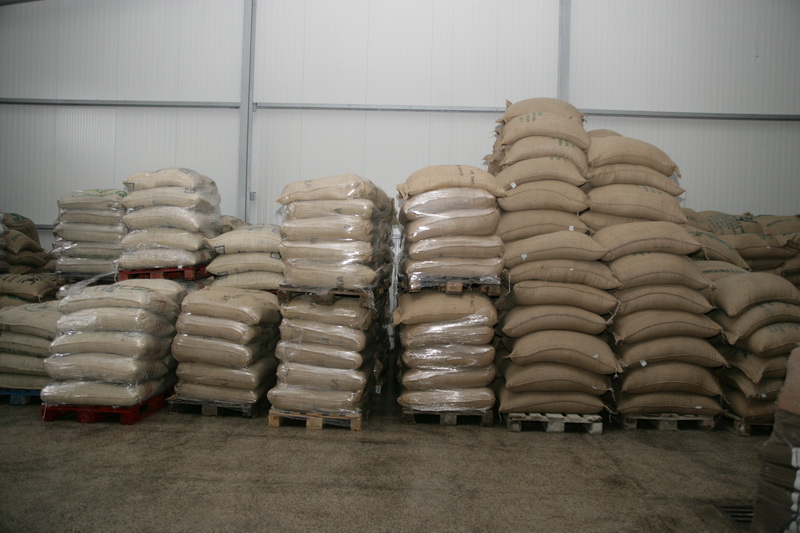 Bulk consignments of green coffee beans are delivered to Cherie LLC in 60-70kg sacks, from the coffee producing countries (Brazil, Columbia etc.). However, it is interesting to detail how the raw coffee cherries get from the tree, to our factory in Tbilisi. The raw coffee cherries are obviously harvested from the tree in their country of origin and then processed into the 60-70kg sacks that are eventually delivered to Cherie LLC. Once the supplier has sent us samples and received our ‘OK’ to ship the bulk consignment, the sacks are loaded into containers destined for the Georgian shipping terminal of Poti. Then, after a long voyage and passing through customs in Poti, the sacks are transported to our factory warehouse in Tbilisi for storage. Our warehouse is temperature and humidity controlled to achieve the optimal storage conditions for the green coffee beans. A batch of samples is then taken from the consignment and quality checked again by our laboratory. Finally, a small sample is stored in a separate place, for future reference.
Bulk consignments of green coffee beans are delivered to Cherie LLC in 60-70kg sacks, from the coffee producing countries (Brazil, Columbia etc.). However, it is interesting to detail how the raw coffee cherries get from the tree, to our factory in Tbilisi. The raw coffee cherries are obviously harvested from the tree in their country of origin and then processed into the 60-70kg sacks that are eventually delivered to Cherie LLC. Once the supplier has sent us samples and received our ‘OK’ to ship the bulk consignment, the sacks are loaded into containers destined for the Georgian shipping terminal of Poti. Then, after a long voyage and passing through customs in Poti, the sacks are transported to our factory warehouse in Tbilisi for storage. Our warehouse is temperature and humidity controlled to achieve the optimal storage conditions for the green coffee beans. A batch of samples is then taken from the consignment and quality checked again by our laboratory. Finally, a small sample is stored in a separate place, for future reference.
Cleaning and Sorting the Raw Green Coffee Beans
 The raw green coffee beans are transferred from their sacks into a hopper, where they are then fed into a bucket conveyer and then on to a so-called ‘separator’. The ‘separator’ sieves and separates the stones, defects and spoil from the beans (pebbles, miscellaneous debris and defective coffee beans etc.).
The raw green coffee beans are transferred from their sacks into a hopper, where they are then fed into a bucket conveyer and then on to a so-called ‘separator’. The ‘separator’ sieves and separates the stones, defects and spoil from the beans (pebbles, miscellaneous debris and defective coffee beans etc.).
Cleaning and Sorting the Raw Green Coffee Beans
 By this stage the green coffee beans have passed through the ‘separator’ and have been cleaned. At this point the cleaned beans are carried by another bucket conveyer into one of five hoppers. Each hopper has a capacity of 1.7 metric tons and one specific type of bean is stored in each hopper.
By this stage the green coffee beans have passed through the ‘separator’ and have been cleaned. At this point the cleaned beans are carried by another bucket conveyer into one of five hoppers. Each hopper has a capacity of 1.7 metric tons and one specific type of bean is stored in each hopper.
Roasting
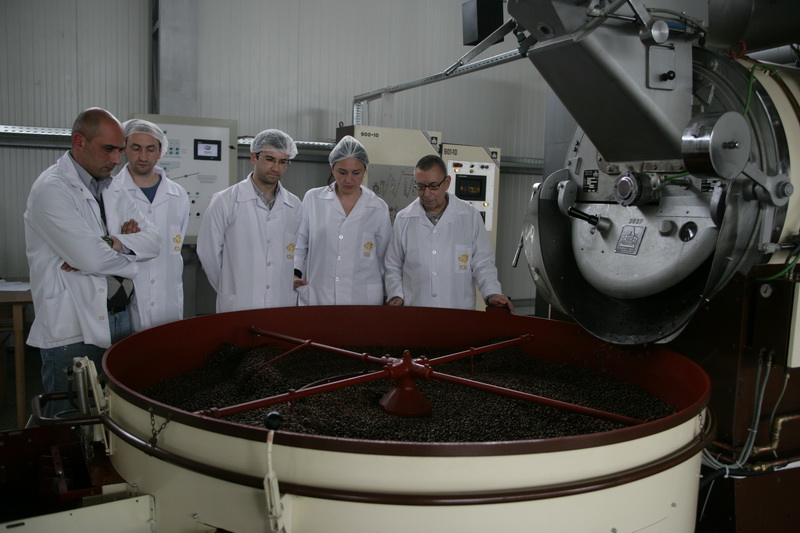 Once the cleaned green coffee beans have been processed into the five storage hoppers, they are then fed into a section of the machine that divides them into a bin by weight, in this case 120 kg. This 120 kg bin of green coffee beans is then fed into a German made “PROBAT-Werke” roaster, which is a first-class piece of German engineering that roasts each 120 kg of beans, in a 15-17 minute time interval. The “PROBAT-Werke” roaster solves several coffee roaster design issues, the result of which is a very high-quality end product.Additionally, the machinery typically keeps on working for decades. There are several complexities to the roasting process, for example it starts endothermically and then becomes exothermic. Consequently, the roasting process is fully computer controlled. Additionally, certain characteristics of the end product can be fine-tuned via the computer control system to achieve best flavour and certain caffeine content.
Once the cleaned green coffee beans have been processed into the five storage hoppers, they are then fed into a section of the machine that divides them into a bin by weight, in this case 120 kg. This 120 kg bin of green coffee beans is then fed into a German made “PROBAT-Werke” roaster, which is a first-class piece of German engineering that roasts each 120 kg of beans, in a 15-17 minute time interval. The “PROBAT-Werke” roaster solves several coffee roaster design issues, the result of which is a very high-quality end product.Additionally, the machinery typically keeps on working for decades. There are several complexities to the roasting process, for example it starts endothermically and then becomes exothermic. Consequently, the roasting process is fully computer controlled. Additionally, certain characteristics of the end product can be fine-tuned via the computer control system to achieve best flavour and certain caffeine content.
Cooling
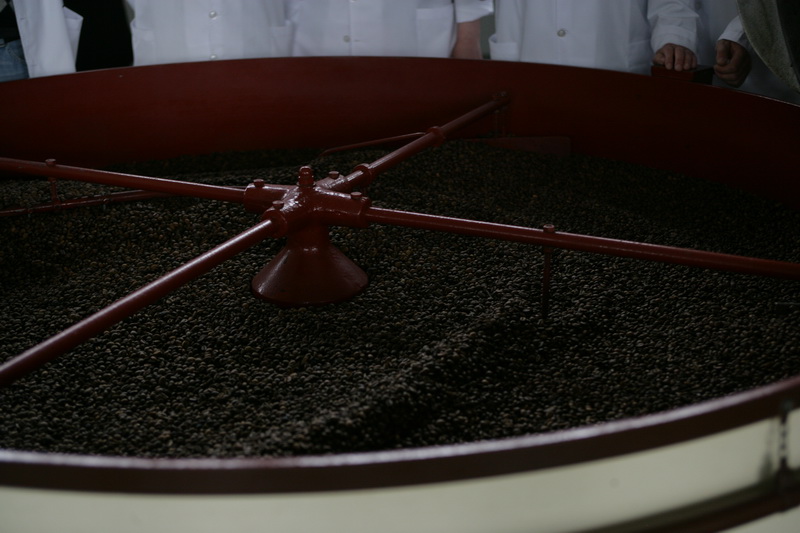 Cooling is a continuation of the computer controlled roasting process and the freshly roasted coffee beans are transferred onto the ‘cooling table’ at a precisely controlled moment in time. On the cooling table, cool air is blown through the beans for a period of 2-3 minutes.
Cooling is a continuation of the computer controlled roasting process and the freshly roasted coffee beans are transferred onto the ‘cooling table’ at a precisely controlled moment in time. On the cooling table, cool air is blown through the beans for a period of 2-3 minutes.
Laboratory Sampling of the Freshly Roasted Coffee Beans
 At the end of the cooling process one of the laboratory assistants will collect and take a sample of the freshly roasted beans to the laboratory. Here, the sample is first tested for it’s moisture content and a comparison is made with the original moisture content of the raw green coffee beans, so as to determine the change in moisture content. Next the beans are ground using a mini-grinder so that the colour can be checked with a spectrophotometer. At this point the freshly ground coffee is brewed and tasted. Assuming the sample passes all of Cherie LLC’s quality checks, the batch is then deemed fit to go on to the final sorting stage. Finally, part of the sample is retained by the laboratory for future reference.
At the end of the cooling process one of the laboratory assistants will collect and take a sample of the freshly roasted beans to the laboratory. Here, the sample is first tested for it’s moisture content and a comparison is made with the original moisture content of the raw green coffee beans, so as to determine the change in moisture content. Next the beans are ground using a mini-grinder so that the colour can be checked with a spectrophotometer. At this point the freshly ground coffee is brewed and tasted. Assuming the sample passes all of Cherie LLC’s quality checks, the batch is then deemed fit to go on to the final sorting stage. Finally, part of the sample is retained by the laboratory for future reference.
Sorting the Freshly Roasted Coffee Beans
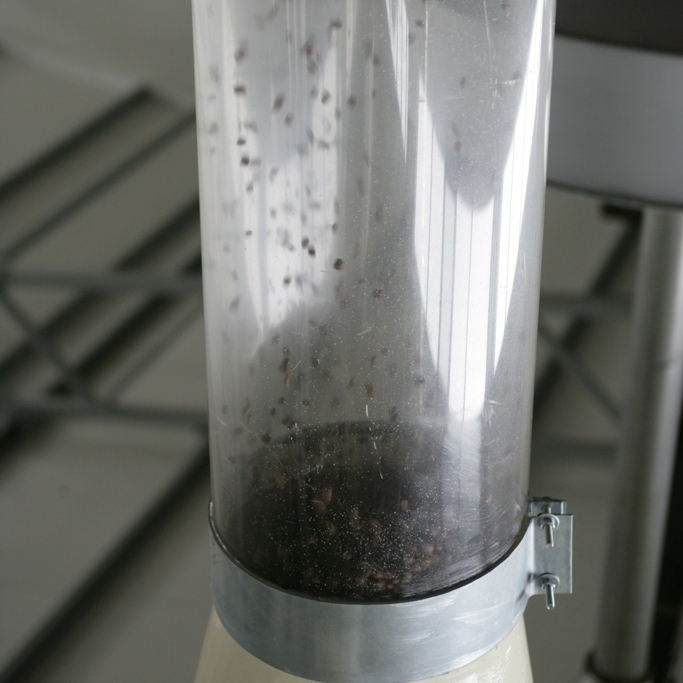 At this stage, most of the freshly roasted beans will be ‘good’, however some of the beans will be deemed as ‘bad’. This determination is effectively made by weight, with the ‘good’ beans having a weight within range and the ‘bad’ beans having an out-of-range weight. From the ‘cooling table’ the ‘good’ beans pass into an intermediate hopper by means of an air-blown sorter. (also called destoner) Beans of a ‘good’ weight therefore pass into the intermediate hopper, in contrast to ‘bad’ beans which are blown out into a different path by the air pressure (and discarded).
At this stage, most of the freshly roasted beans will be ‘good’, however some of the beans will be deemed as ‘bad’. This determination is effectively made by weight, with the ‘good’ beans having a weight within range and the ‘bad’ beans having an out-of-range weight. From the ‘cooling table’ the ‘good’ beans pass into an intermediate hopper by means of an air-blown sorter. (also called destoner) Beans of a ‘good’ weight therefore pass into the intermediate hopper, in contrast to ‘bad’ beans which are blown out into a different path by the air pressure (and discarded).
From the Intermediate Hopper to the Roasted Coffee Hoppers
 The machine operator will open the intermediate hopper, when it is full, and the ‘good’ freshly roasted beans are then taken by bucket conveyer to one of the 5 roasted coffee hoppers. Each of the roasted coffee hoppers can hold up to 1.4 metric tons of beans. The reason for having 5 hoppers at this stage is so that different types of coffee bean can be stored in each hopper, for the purpose of mixing different types of beans to create a blend.
The machine operator will open the intermediate hopper, when it is full, and the ‘good’ freshly roasted beans are then taken by bucket conveyer to one of the 5 roasted coffee hoppers. Each of the roasted coffee hoppers can hold up to 1.4 metric tons of beans. The reason for having 5 hoppers at this stage is so that different types of coffee bean can be stored in each hopper, for the purpose of mixing different types of beans to create a blend.
Mixing
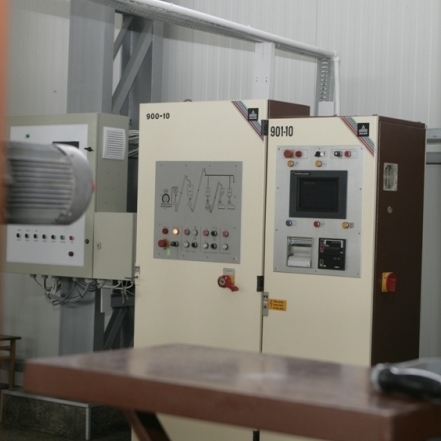 The machine operator can control the mixing of coffee beans from the 5 roasted coffee hoppers, or in other words determine the ‘blend’, by making the appropriate selections on the computer control system. Once the mix is selected, the machine then proceeds to mix 35 kg units of beans from the various roasted coffee hoppers.
The machine operator can control the mixing of coffee beans from the 5 roasted coffee hoppers, or in other words determine the ‘blend’, by making the appropriate selections on the computer control system. Once the mix is selected, the machine then proceeds to mix 35 kg units of beans from the various roasted coffee hoppers.
The Fermentation Hopper
 By means of another bucket conveyer, the mixed beans are then moved into the fermentation hopper which has a capacity of 4 metric tons. Here, the mixed blend is held for 24 hours, which allows the fermentation process to end, thus achieving the final flavour of the mix.
By means of another bucket conveyer, the mixed beans are then moved into the fermentation hopper which has a capacity of 4 metric tons. Here, the mixed blend is held for 24 hours, which allows the fermentation process to end, thus achieving the final flavour of the mix.
Grinding
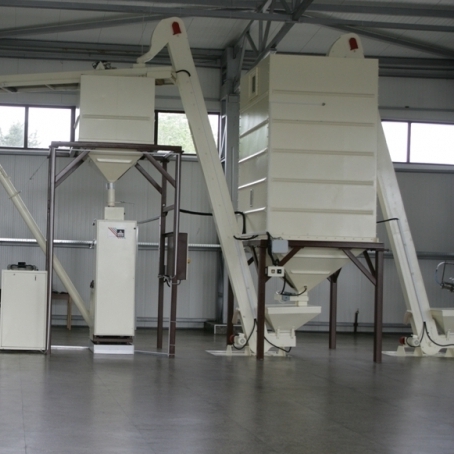 Grinding is again another critical stage in freshly ground coffee production. Grinding is critical in terms of the reproducibility of the final product and care must be taken to keep the temperatures low, in order to preserve the delicate aromas of the coffee. Again, Cherie LLC makes use of the first-class German made “PROBAT-Werke” machinery in the grinding process. After the 24 hour delay from the previous stage, the mix is fed into a 200 kg hopper above the“PROBAT-Werke” grinder, which has the capacity to grind 500 kg of freshly roasted coffee beans per hour. The consistency of the ground coffee is extremely homogeneousand the consistency itself (particle size) is determined by the “PROBAT-Werke” grinder settings beforehand.
Grinding is again another critical stage in freshly ground coffee production. Grinding is critical in terms of the reproducibility of the final product and care must be taken to keep the temperatures low, in order to preserve the delicate aromas of the coffee. Again, Cherie LLC makes use of the first-class German made “PROBAT-Werke” machinery in the grinding process. After the 24 hour delay from the previous stage, the mix is fed into a 200 kg hopper above the“PROBAT-Werke” grinder, which has the capacity to grind 500 kg of freshly roasted coffee beans per hour. The consistency of the ground coffee is extremely homogeneousand the consistency itself (particle size) is determined by the “PROBAT-Werke” grinder settings beforehand.
Final Laboratory Inspection
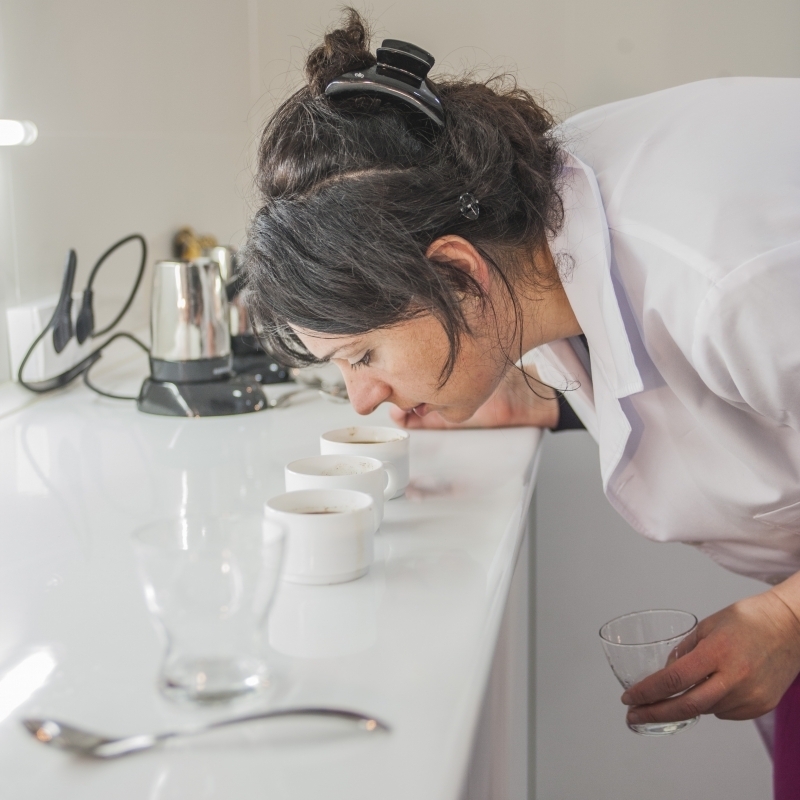 After the freshly roasted ground coffee has passed through the “PROBAT-Werke” grinder, it falls onto another conveyer destined for the packaging stage. It is at this point that a laboratory assistant takes another sample from the conveyer, and this sampling process is repeated for every 200 kg batch of coffee moved into the hopper above the “PROBAT-Werke” grinder. The laboratory checks are similar to those previously described In summary, the moisture content and colour are quality tested, as well as the final brewing and tasting quality check. Assuming that this specific batch meets Cherie LLC’s strict quality standards, it is allowed to move on through the packaging stage.
After the freshly roasted ground coffee has passed through the “PROBAT-Werke” grinder, it falls onto another conveyer destined for the packaging stage. It is at this point that a laboratory assistant takes another sample from the conveyer, and this sampling process is repeated for every 200 kg batch of coffee moved into the hopper above the “PROBAT-Werke” grinder. The laboratory checks are similar to those previously described In summary, the moisture content and colour are quality tested, as well as the final brewing and tasting quality check. Assuming that this specific batch meets Cherie LLC’s strict quality standards, it is allowed to move on through the packaging stage.
Packaging
 A 200 kg batch of freshly ground roasted coffee is moved by conveyer from the previous stage into a 200 kg hopper above the packaging equipment. Assuming that this batch has passed the quality control procedures from the previous stage, the batch is fed into the packaging machinery. The packaging machinery has the capability of filling packs of different weights, all of course with the distinctive Cherie LLC package branding artwork.The packaging machine also inserts a special valve into each pack, so as to prevent the oxidisation of the coffee, while allowing carbon dioxide to escape. Consequently, the freshly ground roasted coffee is kept fresh for an extended period of time.
A 200 kg batch of freshly ground roasted coffee is moved by conveyer from the previous stage into a 200 kg hopper above the packaging equipment. Assuming that this batch has passed the quality control procedures from the previous stage, the batch is fed into the packaging machinery. The packaging machinery has the capability of filling packs of different weights, all of course with the distinctive Cherie LLC package branding artwork.The packaging machine also inserts a special valve into each pack, so as to prevent the oxidisation of the coffee, while allowing carbon dioxide to escape. Consequently, the freshly ground roasted coffee is kept fresh for an extended period of time.
Storage of the Final Product
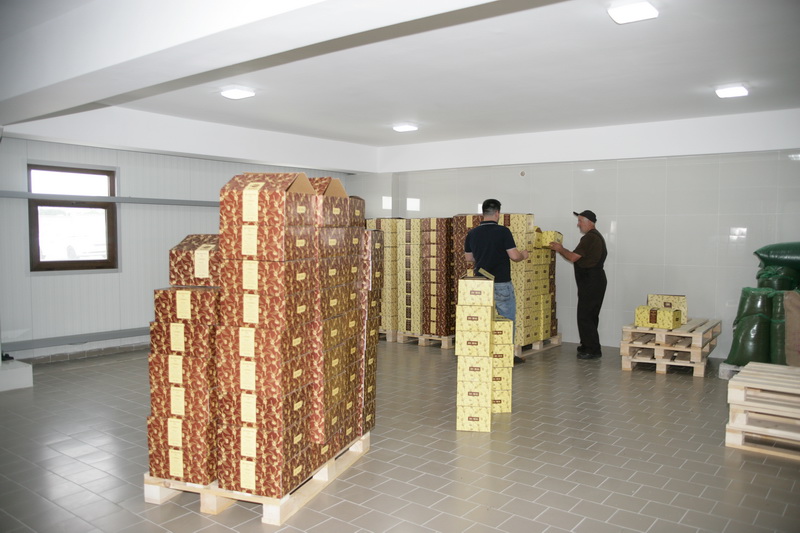 Packs of freshly ground roasted coffee from the packaging machine are now packed manually into cardboard boxes with the Cherie LLC trademark logo on them. Full boxes are then temporarily moved into the distribution area of the warehouse. Typically, the boxes spend less than 4-5 days in the warehouse before being loaded onto lorries, which then transport them to a network of retail stores. Moreover, we adjust our rate of production so that on average freshly roasted coffee from the Cherie LLC factory appears on the shelves of stores just maximum 5 days after it is ground! This is the end of our production story, and we hope that you found it informative and interesting.
Packs of freshly ground roasted coffee from the packaging machine are now packed manually into cardboard boxes with the Cherie LLC trademark logo on them. Full boxes are then temporarily moved into the distribution area of the warehouse. Typically, the boxes spend less than 4-5 days in the warehouse before being loaded onto lorries, which then transport them to a network of retail stores. Moreover, we adjust our rate of production so that on average freshly roasted coffee from the Cherie LLC factory appears on the shelves of stores just maximum 5 days after it is ground! This is the end of our production story, and we hope that you found it informative and interesting.
The production of freshly roasted coffee looks simple but indeed it is a complex and complicated process. In fact, it is as much an art borne out of experience, as it is a science.Also, there are several stages in the process, each of which must be controlled correctly, in order to produce the perfect freshly roasted product. By means of a graphical explanation, clicking on the right lever (in the image to the left) will guide you through our production process, step by step (left lever to go back).
